
Monday April 14, 2008
Scalextric has produced a fantastic set of 1/32 scale model slot cars of two classic F-1 cars, the 1967 Lotus 49 and Eagle T1G. I am so happy that I got these cars and I wouldn’t have if I had not preordered them months ago – Thanks Slot Car World!
A Little History
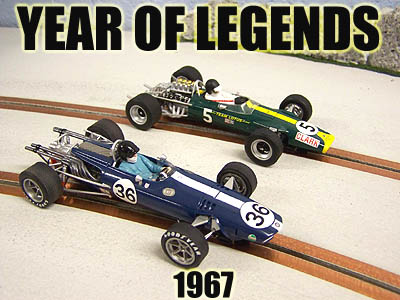
by Rich McMahon
& Harry Wise
The year of 1967 can truly
be called an epoch for Grand Prix racing – it is considered the penultimate of
the “classic” GP years. This was the final season that the cars were painted
in the colors representing their country of origin, it is the final year before
corporate sponsors and ugly aerodynamic appendages appear on F-1 cars. This was
also the second year of the 3.0 liter formula, the so called “return to power”,
after the previous 1.5 liter engine rules.
Racing in this era
was much different than today. A number of talented American drivers had
infiltrated the Grand Prix ranks and the Formula One drivers had also come to
the lucrative North America races venturing to try the Indy 500, stock cars, the
Can Am series and long distance sports car races. There were also
non-championship Formula one races and only six to ten points scoring Grand Prix
races in a year, plus many of the top drivers also competed in Formula 2 races.
But it was also extremely dangerous and often tragic - in the next few years
such great drivers as McLaren, Rindt, Siffert, Clark and Bandini would all
perish in their race cars.
It was a fascinating season
of Grand Prix racing and interestingly that the Lotus nor the Eagle would win
the 1967 World Championship that year. Neither the Lotus 49 or the Eagle
lived up to their potential that season, both being hampered by terrible
reliability, but the new Lotus and the handsome Eagle had glorious moments.
Instead both the drivers and constructors championship would go to the talented
and hard working Repco-Brabham team with Denny Hulme crowned the Grand Prix
champion at the very last race of the year just barely beat out his teammate and
team owner Jack Brabham (imagine that today!). The elegant simplicity of the
Brabham provided outstanding reliability with competitive performance that on
occasion was greater than the Eagle and Lotus - very impressive when you
consider the engine power of the Brabham was much less than the other cars.
The Eagles finest moment
was when American Dan Gurney had an historic win at the Belgium Grand Prix held
on the fast Spa circuit. This was an extremely rare victory for an American
car in a Grand Prix, this had not occurred in over thirty years. This would also
make Gurney one of the few people to win in a car they constructed themselves (Brabham
& McLaren being the other two). This car was very competitive and would lead
numerous races but the reliability was always an issue and it would only win one
GP (and also one non-Championship F-1 race). The Eagle T1G with the Weslake
V12 engine is considered to be the most aesthetically pleasing F-1 car ever
made. The last time it would race would be the 1968 Italian GP at Monza.
Another very
aesthetically pleasing racecar is the Lotus 49 with the Cosworth DFV engine.
This car was the technical triumph of the year and scored a sensational debut
win at the Dutch GP. The combination of this car, the new Cosworth DFV engine
and Jimmy Clark, considered the best driver of the period and one of the best
ever, would win four races that year including the last two, one with a rear
wheel askew. The car would also let down this phenomenal driver while leading
the German and Italian Grand Prix races. This combination was so dynamic that
during the Italian GP at Monza Clark would initially lead but would go a lap
down due to stopping to change a tire. But he would get his lap back and charge
back into the lead, this is the only time someone has fallen back so far and
come back to lead the race again. With victory almost assured the Lotus would
run out of gas but still finish on the podium. Tragically Jimmy Clark perished
the next year. The Lotus 49 would be raced for three more years and it was so
good that it continued to win races in 1970 in it’s fourth season of racing.
The Slot Cars
These models come in the
usual Scalextric card board double car set box. It is a very impressive
looking package but I don’t think this allows for easy display. I would prefer
something that has a clear window that exposes the cars for viewing. (Note:
this is really the only complaint I have about these cars!)
The first impression
upon opening the box is WOW! These racecars look fantastic! For me these
models have the shape, details and decoration of the real cars they are based
off of. Every time I look at them I notice another detail such as the screens
in the front radiator air intake or the Eagle’s twelve tiny engine inlets that
are obscured underneath the screen directly behind the drivers head. I’m sure
there are some small liberties taken with the modeling of these cars, they are
rather small in this scale, but the overall effect is fabulous.
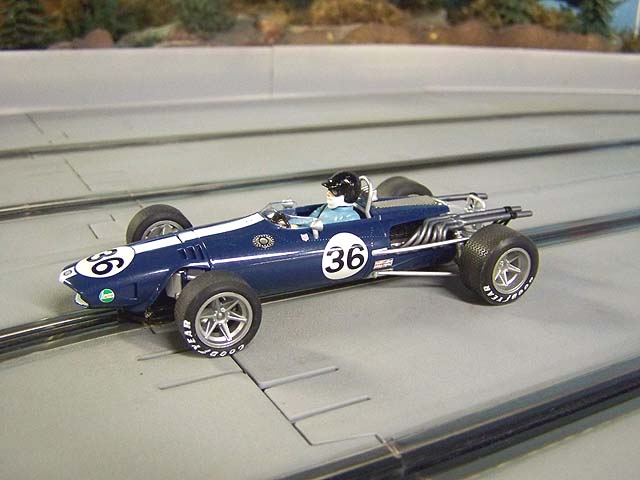
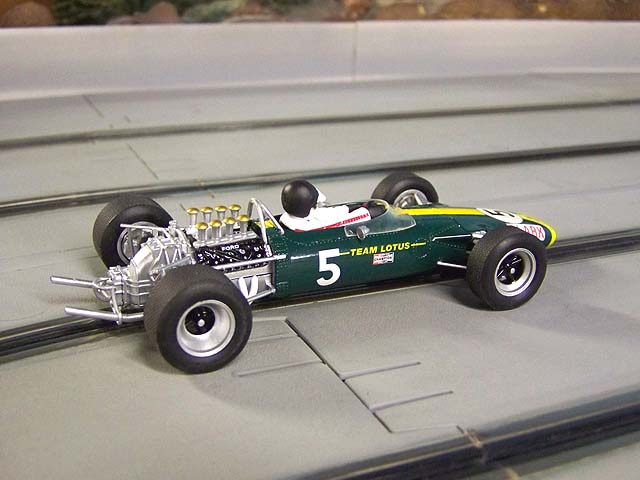
I have had my fair share of boxed sets over the years. Each one is special to me, but when I first opened this box it literally took my breath away. As I looked closer I could not believe how well Scalextric has re-created this models in our scale. Fly detail? Sorry Fly, but Scalextric has proven to me they are just as good...if not better.
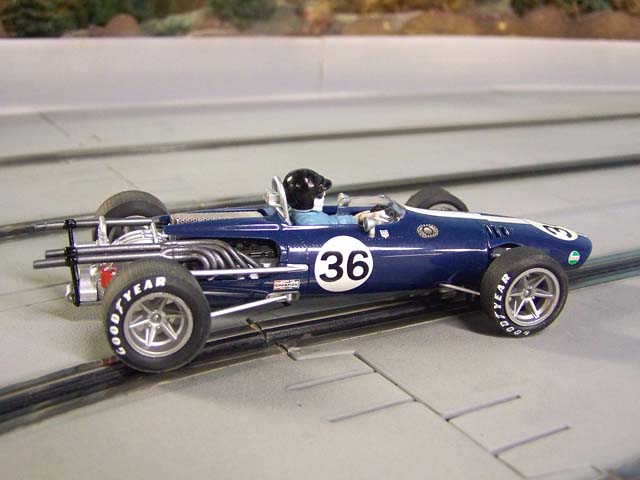
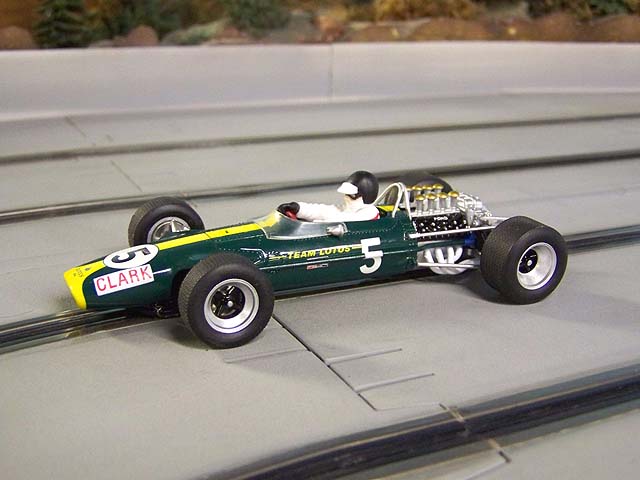
I have just marveled at
these cars and wondered how many hours it would take me to make one of these on
my own. Probably too many for me to even consider starting one – and now I
don’t have to – Thank you Scalextric! With full drivers figures, exposed
engine and suspension detail I can not ask for anything more.
I thought it odd
that the Jim Clark Lotus has the driver’s helmet done in a flat black, I thought
he always wore a dark blue one, but my expectations are probably wrong and I
would think Scalextric got this detail correct.
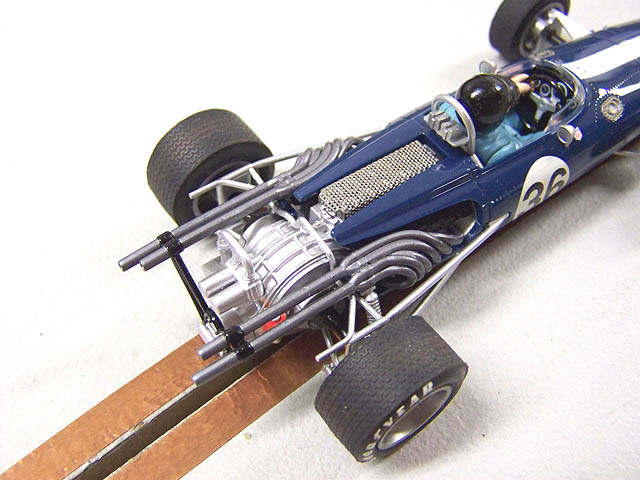
Check out the detail on these engines!
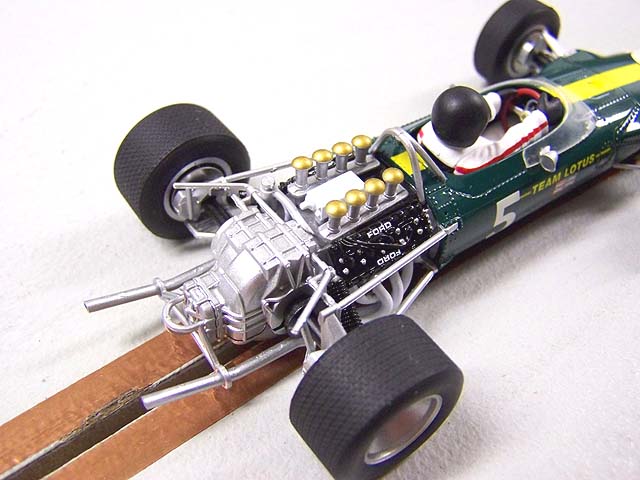
Of course they are slot
cars and Scalextric has delivered some great running cars with these two classic
GP racers. First thing I noticed when I put one of these on my track was I’m
happy I had painted my track grey, these cars just looked too good to just blend
into the background on a black track. Both cars ran smooth and quiet right out
of the box. I did not have to oil or sand or adjust anything. I have only
run them one at a time and I’m curious how well they race together since the
traction magnet locations on the Eagle is much further aft than on the Lotus.
A Closer Look
Wheels and tires are nicely done on each model and were very round and true out of the box. The tire compound is a medium to soft so it should hook nicely on both wood and standard plastic tracks.
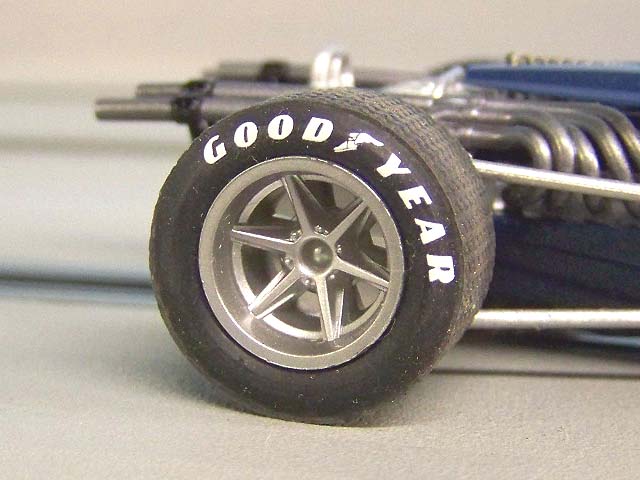
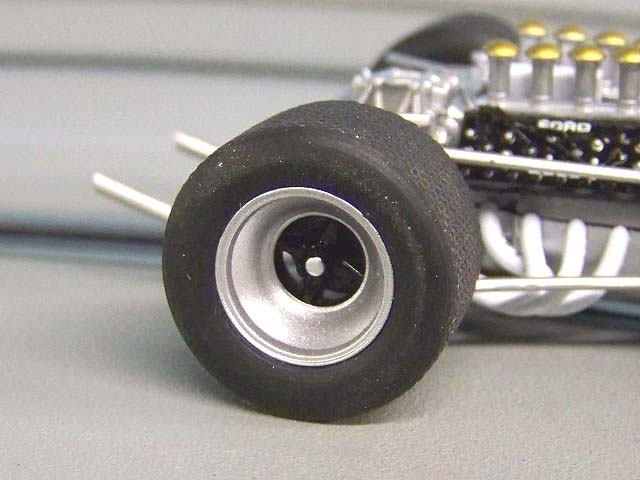
Looking underneath we see the standard button magnet and like Rich mentioned, one is placed a little further back than the other. This might have an effect in how evenly matched the cars will be.
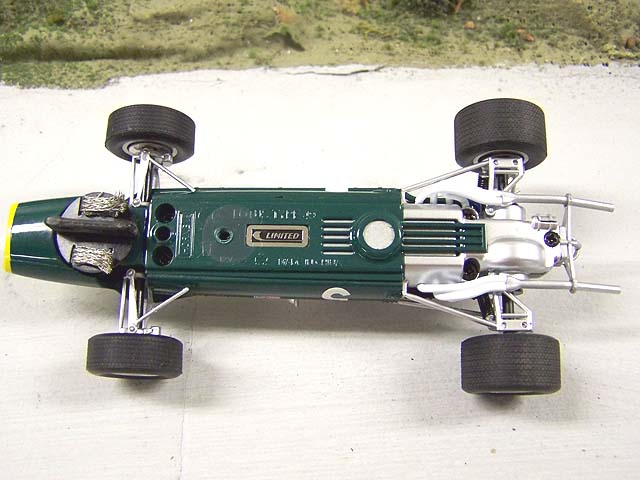
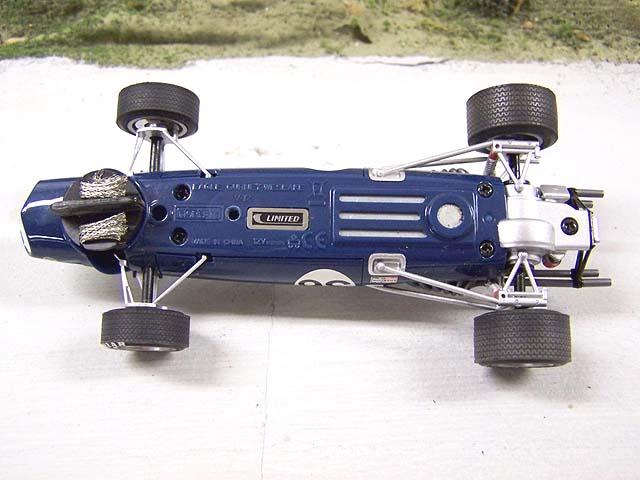
After removing the body mount screws we can get a look inside. Take care removing the bodies as you have some delicate areas here. The motor has no markings so I cannot give any RPM ratings. It has a 9 tooth pinion which turns the 27 tooth crown gear.
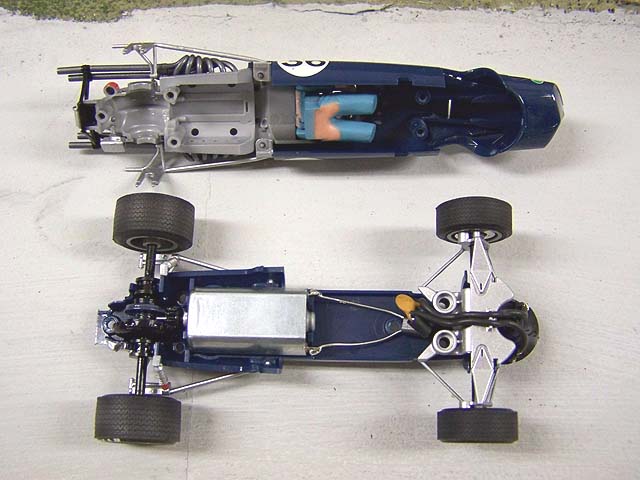
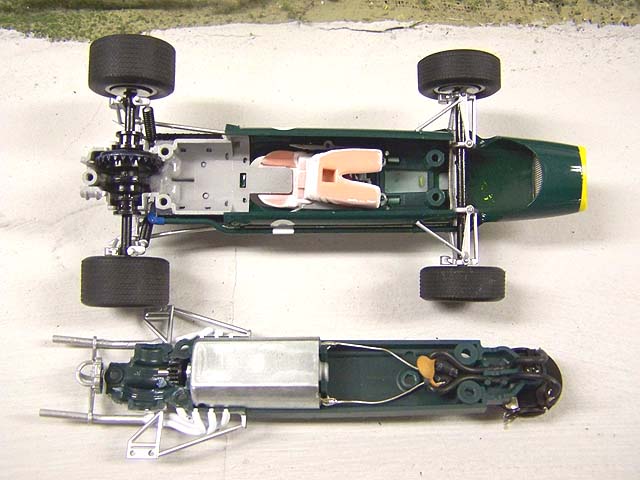
The Tech sheet Scalextric has lists a number, but I cannot find any reference to that number on the site. In any event, most of you will be happy with these cars in stock form. I plan to re-motor mine in the future though to tame them even more to suit my style.
Road Test
Artin Plastic Track - 12 Volts - 25 OHM Parma Control
The first few laps with both these cars told me we had a set of road rockets. The cars have more than enough power, in fact too much for my driving style, but they were SMOOTH and they functioned exactly as intended. The magnet placement did not seem to really give an advantage either way as our lap time averages were 3.9 seconds for both cars. In fact, I found the Lotus to be easier to control as the break away effect was slightly reduced.
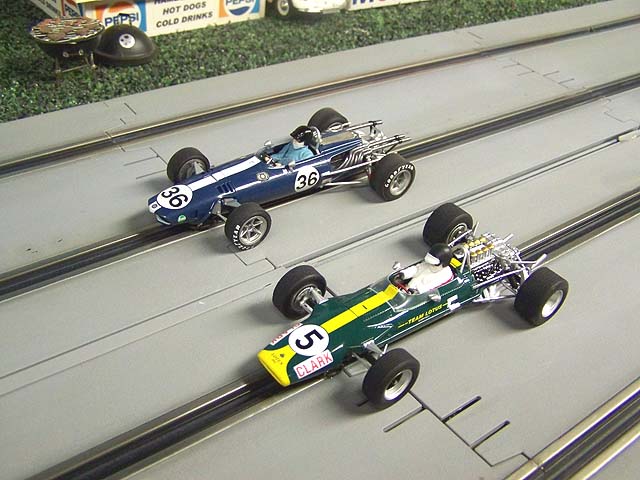
I reduced the power to 10 1/2 volts and they were a much improved pair of models for my taste. Not as punchy and easier to float though the tighter corners.
Road Test
3 Lane Routed MDF - 10 1/2 Volts - 25 OHM Parma Control
It was here on the wood where I really wanted to try these cars. And happily I can report that what we have here is 2 smooth legends that will only get better with a little tuning. I sanded the tires on both models and each one had a 5.5 second average. This is pretty good for our track and the tires seemed to grip well. Perhaps after-market tires would improve things, but I think with these models they will stay box stock.
The only downside to these cars is availability. They are already sold out and it appears no more are coming, at least that is the word I have at this time. It would make sense for Scalextric to re-release them individually later on, so I am going to be optimistic. This is a great series of models and this could easily be the start of a long running line. Hopefully this is the case as a lot of time and effort went into to making them, and not to continue them would almost be a crime.
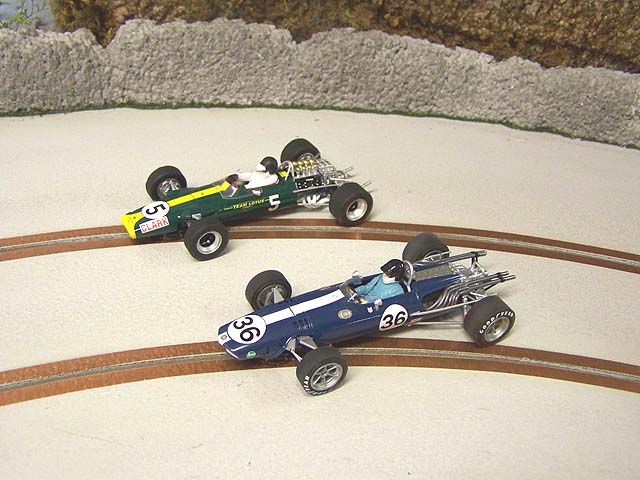
Final Thoughts From Rich
On my Artin track with the power supply at 10 1/2 volts and 35 ohm controllers these cars were fun. Immediately I was clicking off lap after lap. The throttle control was good and the cars seemed to have a good top speed without being uncontrollably fast. They exhibited good response, that is a reasonable change in speed with a change in the position of the throttle control, this made them fun to drive into and out of the corners. The car would slide a bit when over driven, but only a little bit, once the center magnet was not over the power rails and magnetic traction was lost the cars tumbled out of the slot. Overall they were very drivable and addictively fun. I can’t wait to race them against one another.
-Rich
Thanks Go To Slot Car World For This Set!
Copyright © 2008 HomeRacingWorld.com All Rights Reserved